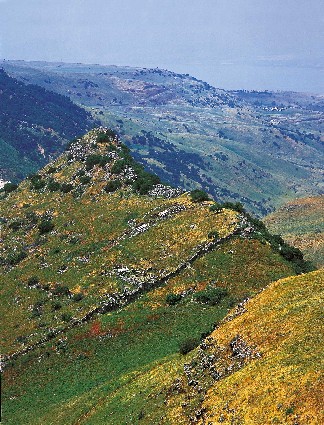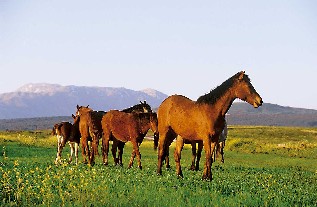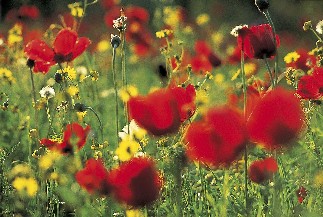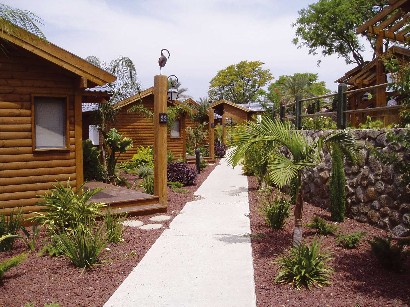|
ERETZ Magazine
|
Stayput Golan
There is no other place in the
northern part of Israel with the wide open expanses of the Golan –
the beautiful plateau of the southern Golan, the canyons and valleys
in the center, and the mountain range of the Hermon, rising up to
its snow-capped peak.
The small hamlet of Dabura already was abandoned in 1888 when
Gottlieb Schumacher, the German architect and explorer, visited it
in 1885. Bedouins had set up tents next to the ancient basalt houses
that stood on the hill overlooking the Hula Valley. Later, after the
creation of Israel, Syrian soldiers set up an outpost between the
houses – in preparation for
 an
Israeli attack. an
Israeli attack.
Schumacher had examined the houses and discovered that many ancient
sculptures had been reused in their walls. In 1969, after the Six
Day War, a basalt lintel was discovered on one of the houses with
the Hebrew inscription, “This is the beit midrash of Rabbi Elazar
the Caper Maker.” The discovery tied into an interesting discussion
in the Talmud about “dangling on Shabbat.” Dangling, that is
carrying a light object in your hands, is not allowed according to
Jewish law. The Talmud gave examples of things that one should not
do in order to avoid carrying on the Shabbat. One of the things was
“not to wear new shoes.” What are new shoes? the Talmud asks. Shoes
that have not “walked” a certain distance – for example, a distance
equal to the distance between the synagogue at Katzrin and the beit
midrash of Rabbi Elazar the Caper Maker. The ancient talmudic
synagogue of Katzrin is located in what is today Katzrin’s
archaeological park and the beit midrash is a short distance away –
about 4 kilometers as the Golan raptors fly.
The Golan is full of surprises and exciting discoveries such as
these – interesting historical connections, ancient ruins hidden
away in beautiful ravines, natural oak forests, ancient fortresses
and fortified cities, and above all, the great outdoors, grazing
lands, vineyards, and farms of this region.
(Back to top)
Gamla
The town of Gamla was built on the slope of a camel-like hill
jutting out of the Daliyot riverbed. One side of the hill is a sheer
cliff, the other is a steep slope on which the houses of the town
were constructed, along with a synagogue, ritual bathhouse, and
various other public buildings. A wall surrounded the town.
From the time of King Herod, in the first century BCE, the Jewish
population of Gamla resisted the Greek influences that Herod had
imported into the land. After initial battles with Herod and the
Romans, the town became the seat of the family of Hezekiah the
Galilean, who led what Josephus Flavius called “the party of the
Sicarii.” A sica was a small dagger and the Sicarii were known to carry them in order to stab
their opponents.
dagger and the Sicarii were known to carry them in order to stab
their opponents.
When the war against the Romans broke out, Gamla was one of the
strongholds of the Jewish rebels. In the year 68 CE, the Roman
legions besieged the town. A siege wall was set up and the
legionaries attacked the walls again and again – to no avail.
Finally, the siege paid off. In one last effort, the Romans breached
the walls and stormed the city. The defenders and their families
gathered at the top of the town, on top of the cliff, and in order
not to fall into the hands of the Romans they committed suicide,
jumping to their deaths. The last of the Sicarii would, five years
later, commit suicide on Masada.
(Back to top)
Vines and Wine
The Golan Height’s geographic and climatic conditions make it an
ideal place to grow grapes and produce wine. Many refer to the Golan
Heights as Israel’s wine country because of the dozens of wineries
located there; almost all of them offer tours.
The Chateau Golan Winery offers tours seven days a week that explain
its winemaking philosophy and include a visit to its wine cellar and
a tasting of a selection of its wines. The winery’s garden and wine
cellar also can be
 rented
for small events and parties (Moshav Eliad, Tel. (04) 660-0026,
reservations required, not kosher). rented
for small events and parties (Moshav Eliad, Tel. (04) 660-0026,
reservations required, not kosher).
The Bazelet Hagolan winery specializes in cabernet sauvignon made
with grapes grown on the Golan’s rich, fertile basalt lands. The
winery offers tours and during the harvest season (from Rosh Hashana
to Sukkot) visitors also can observe the winemaking process (Moshava
Kedmat Zvi, Tel. (04) 696-5010, reservations required, kosher).
(Back to top)
Cowboy Chow
The Golan has been very successful in raising cattle thanks to
its rich expanses of grazing land and comfortably chilly climate.
The restaurant that captures the Golan’s Wild West atmosphere best
is Habokerim (Hebrew for cowboys). The tables are covered with
checkered cloths, the bar stools are designed to resemble saddles, a
horse ranch is right outside, and the menu features a variety of
cuts of grilled beef (Kibbutz Merom Golan, Tel. (04) 696-0206,
kosher).
At Hava Bekfar (Hebrew for ranch in the village) on Moshav Ramot,
the menu also features roasted meats and meat stews. Hava Bekfar is
open in the evenings only. Reservations are recommended (Moshav
Ramot,
Tel. (04) 679-7097, not kosher).
Situated atop Mount Kateh, Nimrod is considered the highest Jewish
community on the Golan Heights. It is the site of a restaurant
called Kederat Hamakshefa Vehahalban (Hebrew for the witch and the
milkman’s stew), which specializes in meat and fish stews. It also
serves excellent soups, such as tomato soup with ginger and goat’s
milk yogurt or cream of onion soup served in a loaf of bread.
(Nimrod, Tel. (04) 687-0049, not kosher).
(Back to top)
Nimrod’s Castle
The massive castle on the slopes of Mount Hermon overlooking the
Hula Valley and the ancient town of Banias was built by the Moslem
rulers of Damascus to guard the road leading from Damascus to Tyre.
In the twelfth century, it was turned over to the Assassin sect,
which made it, together with other strongholds in the mountains of
Lebanon, one of their bases. The sect was known for its suicidal
attacks on opposing leaders – both Crusader and Moslem. They
strengthened their spirit before setting out on their missions by
smoking a potent weed that later was named after them: hashish.
After the Crusaders’ withdrawal from the Land of Israel and the
demise of the sect, the castle was turned into a prison for
political leaders and later abandoned.
Touring the castle includes descending into the old prison cells,
walking through a secret exit, exploring the huge dungeon, and
squeezing through some very narrow passageways.
A foot path leads from the castle down to the Banias spring. The
scenic downhill hike takes about two hours; the path meanders
between old oak trees and the remains of a natural forest. The
castle is named after the biblical hero Nimrod.
(Back to top)
Gilbon Hike
Follow the red-marked dirt road that leads from Route 91 to the
Gilbon parking lot (turn right at the junction with the road marked
in blue). Since there are old mine fields here, stay on the trails
and do not climb over fences! The trail down to Nahal Gilbon, marked
in red, starts between the houses. Once across the river, you are at
the top of the Devora Waterfall. Take the blue trail branching off
to the north (right). It leads to Horvat Devora. Return to the
Devora Waterfall, which makes a 12-meter dive into a lovely pool. On
the way to the bottom of the waterfall, you’ll pass fig trees, olive
trees, and prickly pear (sabra) hedges. Oleander bushes beside the
pool bedeck the area with pink flowers in summer; giant reeds and
lilac chaste trees grow beside the channel. The red trail continues
down the river. One kilometer further down the riverbed is the
41-meter-high Gilbon Waterfall. From the observation area, a
blue-marked trail leads off to the right, up the steep slope. After
a strenuous climb, you will reach an unpaved road, marked in blue,
back to the junction with the road marked in red. Turn left and
follow the red road to the parking area where you started.
(Back to top)

Itinerary
Day 1: Northern Golan
Start the tour at Merom Golan. Drive up Mount Bental, one of the
three lines of extinct volcanoes on the Golan. The view from the old
Israeli outpost on the top of the mountain is magnificent. The
Coffee Anan restaurant at the top is a good place for a break. Take
Route 98 to the Druze villages of Ma’sade and Majdal Shams. Take
Route 989 down to Neve Ativ. Continue to Nebi Hazori for a picnic
under the huge ancient oak trees. Continue to Nimrod Castle National
Park for a visit to the huge bastion of the Assassins. Keep going
down the slope to Banias Nature Reserve for a short walk along the
Banias (Hermon) River, which is one of the three tributaries of the
Jordan River.
(Back to top)
Day 2: Central Golan
Start the tour with a visit to the archaeological museum in
Katzrin. Then tour Katzrin’s archaeological park and visit the Golan
Heights Winery. Then take Route 9088 to Route 87 and then to Route
98. Finally, drive down Route 808 to Gamla and end the day with a
visit to Gamla National Park.
(Back to top)
Day 3: Southern Golan
Take Route 98 to the southern part of the Golan. Take Route 789
down the Golan. Stop off at Kursi National Park to visit the site of
the Gerasene Demoniac and the huge Byzantine monastery. Take Route
92 south around the Sea of Galilee to Tiberias. Visit the Hamat
Tiberias synagogue and the tomb of Rabbi Meir Baal Haness. Return
via Route 90 to Route 98 and drive to the Hamat Gader Hot Springs.
Spend the afternoon and evening at the hot springs (bringing a
bathing suit, towel, and soap). Drive up the hairpin turns of Route
98 back to the Golan and follow Route 98 all the way back to Katzrin
and from there back to Merom Golan.
(Back to top)
Day 4: Safed and Hula Valley
Follow Route 91 to Route 90. Turn south on Route 90 to Rosh Pina.
Explore old Rosh Pina and then continue to Safed to visit the city
of the Kabbalists. Don’t miss the ancient cemetery. If time permits,
drive south on Route 90 to visit to the ancient site of Korazim. End
the day with pancakes with real mulberry cream at the Vered Hagalil
horse ranch. Drive back to Merom Golan.
(Back to top)
Day 5: Jerusalem
Enter the Old City via the Jaffa Gate and visit the Tower of
David Museum, whose main exhibit focuses on the history of
Jerusalem. Then walk down David Street, the main souvenir market, to
the first intersection. Turn left onto Christian Quarter Street and
walk to the alley of Saint Helena that leads down to the Holy
Sepulcher. Tour the assemblage of churches that have been built
around the Tomb of Jesus since the third century. Exit by the small
entrance to the courtyard that leads to the Muristan Market. Walk
straight ahead until you reach the busy market street of Khan e-Zeit.
Turn right and walk down the ancient Crusader markets. (Walk along
the central one which has less freshly butchered meat hanging on
hooks in the street.) Once out of the market, turn left on David
Street and make your way round the corner to Sisileh Street. Walk
down the street to the street turning to the Kotel. Walk down to the
Kotel. After visiting the Kotel, take the Rabbi Yehudah Halevi steps
up to the Jewish Quarter. Make your way through the quarter to Zion
Gate, walk out the gate, turn right, and walk along the outside of
the wall back to the Jaffa Gate.
(Back to top)
Day 6: Tel Aviv
Take Route 85 to Route 65. From there, take Route 77 to Route 70
and then take Route 2 to Tel Aviv. Start in the south by exploring
Jaffa’s flea market. Then take a taste of historic Tel Aviv by
strolling through the Neve Tzedek neighborhood, Rothschild
Boulevard, and the surrounding streets. Take a lunch break at one of
the many cafes on Sheinkin Street and then check out the shops along
Dizengoff Street. End the day with dinner on Ibn Gabirol Street.
(Back to top)
The Ramot Resort Hotel
The Ramot Resort Hotel, a holiday village located near Moshav
Ramot, has significantly upgraded its facilities. It now has 12
deluxe chalets that can accommodate couples and 18 nature cabins
designed for families. In addition, there are 80 standard rooms. In
the spring of 2006, 13 additional chalet suites, a luxurious spa,
and restaurants are slated to open.
The deluxe chalets are 60 square meters of pure indulgence. Designer
Osnat Novick used bamboo and soft colors such as light brown, sky
blue, and white to give the chalets an Asian feel that radiates
understated elegance. Each bathroom has a giant shower and sauna and
the main room of the chalet has a huge jacuzzi with decorative blue
lighting and a functioning fireplace. The nature cabins for families
have the same lovely design plus an extra room for the kids. Outside
there is a sweet wooden porch on which the generous breakfast can be
served. The chalets are arranged in diagonal lines in order to
provide guests with as much privacy as possible in a hotel setting.
But, all that aside, the real reason for staying at the Ramot Resort
Hotel is its amazing view of the Sea of Galilee. This isn’t a view
that you have to stretch your head out a window at the correct angle
to see, but a huge blue and green fresco that enchants you while
breakfasting on the porch, lounging in the jacuzzi, enjoying a meal
at the kosher panoramic restaurant, or simply glancing out a window.
The view from the swimming pool also includes mango and apple
orchards that seem to extend into the Sea of Galilee.

(back to top)
|
|